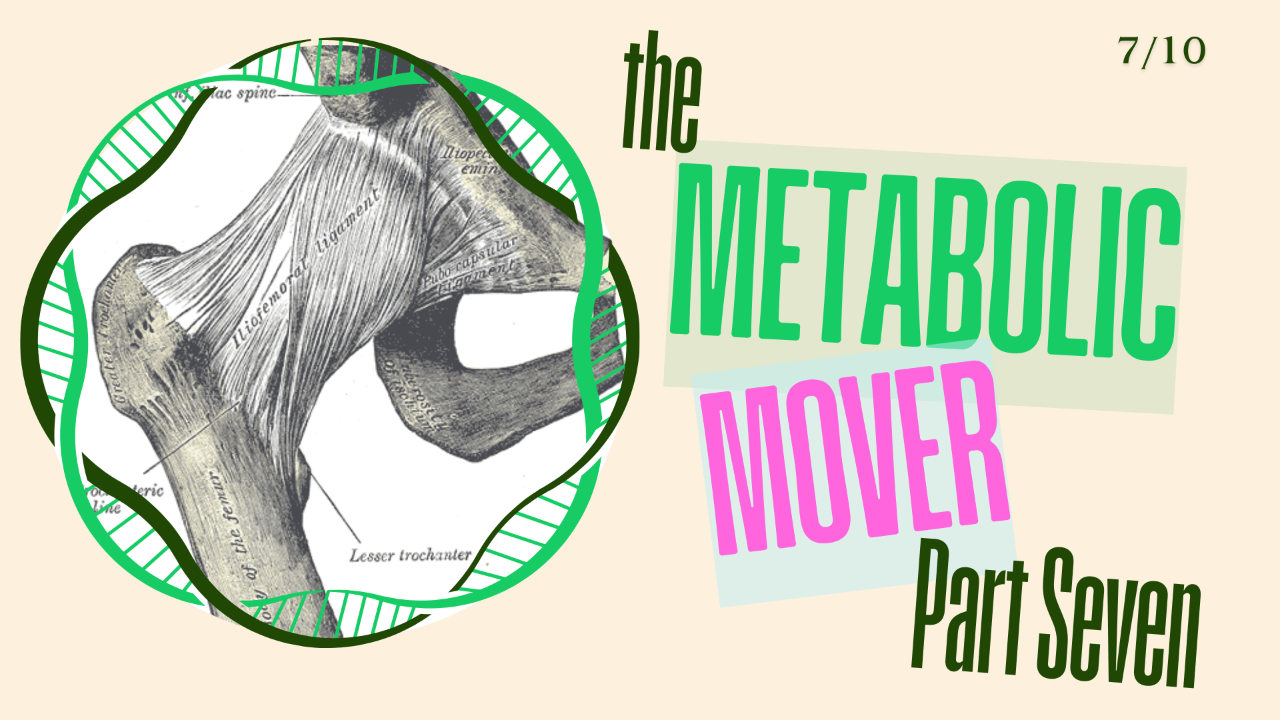
Part 7 of The Metabolic Mover Series
Ever watched a child spin with arms outstretched, face tilted toward the sky? There's something fundamentally human—and profoundly natural—about rotating our bodies through space.
As movement educators, we know intuitively that certain movements "feel right," but have you ever wondered why?
Nature's Spiral Formation
Let me start with a bold claim: Rotation isn't just one way to move—it's the way we've evolved to move.
From the spiraling DNA in our cells to the galaxies spinning above us, the universe seems to favor this elegant pattern. And our bodies are no exception.
This series, The Metabolic Mover, rests on three principles that guide my approach to movement education:
-
To live is to change.
-
To thrive is to experience regulated, progressive change.
-
Regulating change through movement is our greatest opportunity to influence personal health outcomes.
But not just any kind of movement will do!
Rotational, cross-body, "spiral" motion becomes particularly crucial for aging joints. And let's be honest—saying "aging joints" is redundant. We all have joints that are getting older by the minute!
The Universal Pulse of Change
Metabolism is change—the continuous transformation of energy and matter. This principle extends beyond biology; the universe itself has a metabolism that manifests most elegantly as spirals.
From galactic arms to DNA's double helix, spirals represent nature's most efficient transformation path.
Spiral galaxies, including our Milky Way, evolve through dynamic processes of star formation and chemical enrichment (Boissier et al., 1999), while their internal mechanics—gas accretion, mergers, and outflows—function remarkably like metabolic systems (Hopkins, 2010).

This Hubble Space Telescope image shows a group of interacting galaxies called Arp 273. The larger of the spiral galaxies, known as UGC 1810, has a disk that is tidally distorted into a rose-like shape by the gravitational tidal pull of the companion galaxy below it, known as UGC 1813.
These cosmic structures aren't coincidental—they're mathematics made manifest: logarithmic spirals, golden ratios, and Fibonacci sequences governing everything from galactic rotation to the unfurling of fern fronds.
The "universal rotation curve" discovered in spiral galaxies reveals a consistent pattern in how they distribute and transform energy—a cosmic metabolism showing remarkable consistency across vastly different galactic scales (Persic et al., 1995; Kirillov & Turaev, 2006).
Even more fascinating, spiral structures appeared early in cosmic history, with spiral morphology identified in intensely star-forming galaxies more than 12 billion years ago (Tsukui & Iguchi, 2021; Smith, 2021).
As Carlo Rovelli describes in "The Order of Time" (2018):
"The world is not a collection of things, it is a collection of events... A stone is a prototypical 'thing': we can ask ourselves where it will be tomorrow. Conversely, a kiss is an 'event.' It makes no sense to ask where the kiss will be tomorrow. The world is made up of networks of kisses, not of stones."
At every level of existence, what appears static is actually dynamic—metabolism in action.
The Human Spiral: Your Body's Intelligence
This universal spiral pattern finds perfect expression in human form. Our fascia—the connective tissue web interpenetrating our bodies—naturally organizes along spiral pathways, embodying the same mathematical principles that shape galaxies.

Schleip & Müller (2013) confirmed that fascial pathways transmit force through the body. John Sharkey's work goes further, exploring the fascia as a tensegrity system that both stabilizes and enables movement.
John Sharkey, a clinical anatomist and exercise physiologist, has extensively explored the concept of biotensegrity—a model describing how biological structures maintain stability through a balance of tension and compression.
In his 2018 publication, "Biotensegrity-Anatomy for the 21st Century Informing Yoga and Physiotherapy Concerning New Findings in Fascia Research," Sharkey discusses how the fascial network facilitates force transmission throughout the body.
Sharkey emphasizes that fascia provides the scaffolding for muscle attachments and plays a crucial role in distributing mechanical forces, contributing to the body's structural integrity and movement efficiency, and has recently acknowledged the body's response to forces is indeed spiral. Reference for that one is coming soon!
Graham Scarr's publications on the helical cross-ply of the locomotor system shows how these patterns optimize energy expenditure, allowing efficient force transfer with minimal loss—mirroring how spiral galaxies efficiently distribute mass and energy (Sancisi, 1999). Patterson-Kane et al. (1997) found that linear loading actually reduces collagen fibril diameter in tendons, while varied, spiral-oriented loading promotes resilience.
The implications of all this research are profound: linear, repetitive movement patterns contradict our spiral nature, while multi-directional movements honor our inherent, evolving form.
The Silent Dialogue Between Tissues
Fascia's Unique Sensory Language in Our Spiral Framework
Our connective tissues engage in a constant metabolic dialogue beneath our awareness. Incredibly, this internal conversation follows patterns that mirror the universe's fundamental spiral organization. Schilder et al. (2018) revealed that fascia uses a fundamentally different language of sensation than muscle—one that's subtle, gradual, and easily overlooked.
This discovery illuminates that our spiral-organized fascial network communicates in patterns held by the liquid crystalline helical architecture of the collagen matrix. Like fiber optics, the collagen system is characterized by light speed communication.
Fascia innervation is increasingly recognized for its role in proprioception and pain perception. Schilder's work suggest that fascia innervation may prioritize proprioceptive stimuli over pain stimuli, with distinct roles for different types of fascia.
As Scarr (2011) demonstrated, our crossed-helical arrangements of collagen respond to mechanical forces in ways that defy linear prediction. The helical tensegrity structure of connective tissue, with its spiral arrangements at every scale from tropocollagen to myofascial meridians, creates a unique sensory environment where mechanical information propagates through tissue in spiral patterns rather than direct lines.
Sharkey (2015) positioned this sensory organization within a biotensegrity framework, explaining that the body's spiral-based tensional network distributes both force and sensation through geodesic pathways rather than segmental ones.
The spiral distribution of mechanoreceptors throughout fascia that Stecco et al. (2018) mapped aligns perfectly with these cosmic patterns—creating a system where signal propagation follows curved, spiral pathways rather than linear transmission.
When we engage in linear, repetitive movements that contradict our spiral nature, we disrupt the normal spiral-based communication pathways through which connective tissue transmits warning signals.
The upshot: poorly organized movement results in a metabolic disconnect between intent and adaptation, fundamental misalignment with our spiral nature that can result in inflammation, injury, and difficulty healing.
Avison (2015) recognized this phenomenon in movement practice, noting that spiral-based movement patterns engage the fascial network's full sensorimotor capacity.
This explains why ancient movement systems intuitively organized around spiral patterns—they were accessing the fuller sensory dialogue available through our spiral-arranged tissues.
This understanding transforms our approach to both training and rehabilitation. When we add momentum to the spiral nature of our fascial network's sensory apparatus, we restore the coherent dialogue between intent and adaptation that allows for sustainable movement.
As Myers (2014) demonstrated through his Anatomy Trains model, forces and sensations travel along myofascial meridians, creating a sensory network that functions optimally when engaged through multi-directional, spiral-oriented movement patterns.
The revolutionary implication is that adaptation itself follows spiral patterns—not the linear progression models that dominate conventional training. The spiraling dialogue between mechanoreceptors, nociceptors, and cellular responses creates a complex adaptive system that functions according to the same mathematical principles governing spiral galaxies (Boissier et al., 1999) and the unfurling of fern fronds.
By recognizing and working with this spiral-based sensory network, we restore the metabolic coherence that prevents the silent accumulation of tissue damage and allows for sustainable human movement.
Movement as Metabolic Expression
Understanding movement as an expression of universal spiral principles transforms our approach to training, therapy, and movement as healing. It's time to stop hurting ourselves in the name of fitness! Maffulli's research (2000) showing that repetitive strain produces inferior collagen isn't just a clinical finding—it reveals what happens when movement contradicts our spiral essence.
Cultivating rotational awareness honors both universal and human metabolic wisdom. Kjær et al. (2009) identified specific "adaptation zones" for connective tissue, but these zones are most effectively accessed through movements that respect our spiral organization.
Ancient Wisdom and Modern Science
Movement traditions across cultures have long incorporated spiral principles. Tai chi's "silk reeling," Sufi whirling, and yogic rotational patterns all intuitively understand what modern research now confirms: spiral motion represents optimal metabolic function for humans.
Modern movement pioneers have expanded on these insights:
- Dr Joanne Avison has long advocated for rotational, spiral motion in her groundbreaking book, Yoga, Fascia, Anatomy and Movement
-
Dr. Andreo Spina developed Controlled Articular Rotations (CARs), recognizing that joint capsules relay multidirectional information to the central nervous system (Spina, 2014)
-
Dr. Richard Smíšek's Spiral Stabilization approach uses spiral muscle chains to treat conditions like disc herniation without surgery (Smíšek et al., 2009)
-
The Stecco family visualized spirality anatomically with their 14 myofascial segments, demonstrating force transmission through spiral connections (Stecco et al., 2018)
-
Biomechanics researchers like Tittel, Dart, and Shaparenko identified rotational vectors in "muscle slings," showing how spiral arrangements optimize force transmission (Tittel, 2003; Myers, 2014)
-
Fede et al. (2021) discovered "hidden neural networks" in deep fascia, providing a neurological basis for why spiral movement patterns engage these networks in ways linear movements cannot.
Practical Applications: Living the Spiral
This spiral principle extends into consciousness itself. Neurological research by Mense (2003) and Suárez-Rodríguez et al. (2022) reveals how sensory systems integrate movement information through fascial networks.
When we move in spiral patterns, we create coherence between conscious intent and metabolic intelligence—what some traditions call "flow state," where perception, action, and intention spiral together in seamless unison.
Research offers clear guidance for applying this cosmic-human connection. Check out my other posts on caring for fascia, and use the HERLI tool for evidence-based guidance:
-
Heat before loading
-
Embrace multi-directional loading
-
Respect adaptation timelines
-
Listen to subtle signals
-
Incorporate rotational variability
Spirality as Sustainability
Understanding movement as universal spiral metabolism transforms our approach to training and rehabilitation.
By respecting our spiral nature, honoring appropriate adaptation timelines, and embracing movement variability, we don't just improve performance—we participate more coherently in the cosmic metabolism flowing through all things.
From galaxy to genome, from fascia to consciousness, the spiral prevails as nature's elegant solution to sustainable transformation. When we move in spirals, we're not just training our bodies—we're participating in the universe's most fundamental celebration of itself.
Rotational Responsibilities
As movement educators, we have a duty of care to consider the "temporal workspace" of joints.
My thesis as a movement educator is simple: movement practices constrained for rotation bring us into resonance with both the molecular and biomechanical sensibilities of our bodies. As we move in tune with these natural patterns, we harmonize not just with ourselves, but with the greater spirality that pervades nature.
In the next part of this series, we'll continue exploring how rotational movement affects us at the cellular level, particularly focusing on mitochondrial health and metabolism. Spoiler alert: the benefits go far beyond just joint health!
Until Part 8 of The Metabolic Mover comes out next month, you can dive further into the self-care of fascia:
Gains and Strains: The Hidden Cost of High-Intensity Movement Practices (Part 1)
Microtrauma vs. Conditioning: What We Think Is True
The Silent Betrayal: When Your Body's Warning System Fails You
What rotational movement patterns have you found most effective in your teaching? Share your experiences in the comments below.
References
Avison, J. (2015). Yoga: Fascia, Anatomy and Movement. Handspring Publishing. https://www.handspringpublishing.com/product/yoga-fascia-anatomy-and-movement/
Avison, J. (2023). Myofascial Magic in Action: An Experiential Guide to Movement and Fascia in Therapeutic Practice. Singing Dragon. https://uk.singingdragon.com/products/myofascial-magic-in-action
Behm, D. G., & Wilke, J. (2019). Do self-myofascial release devices release myofascia? Rolling mechanisms: A narrative review. Sports Medicine, 49(8), 1173-1181. https://link.springer.com/article/10.1007/s40279-019-01149-0
Boissier, S., Prantzos, N., & Boselli, A. (1999). Chemo-spectrophotometric evolution of spiral galaxies — I. The model and the Milky Way. Monthly Notices of the Royal Astronomical Society, 307, 857-876. https://doi.org/10.1046/j.1365-8711.1999.02699.x
Fede, C., et al. (2021). Evidence of a new hidden neural network into deep fasciae. Scientific Reports, 11, 12665. https://www.nature.com/articles/s41598-021-92194-z
Hopkins, A. (2010). Galaxy Metabolism. Publications of the Astronomical Society of Australia, 27, 233-233. https://doi.org/10.1071/as10012
Kirillov, A., & Turaev, D. (2006). The universal rotation curve of spiral galaxies. Monthly Notices of the Royal Astronomical Society: Letters, 371. https://doi.org/10.1111/j.1745-3933.2006.00202.x
Kjær, M., et al. (2009). From mechanical loading to collagen synthesis, structural changes and function in human tendon. Scandinavian Journal of Medicine & Science in Sports, 19(4), 500-510. https://onlinelibrary.wiley.com/doi/10.1111/j.1600-0838.2009.00949.x
Kondrup, F., Gaudreault, N., & Venne, G. (2022). The deep fascia and its role in chronic pain and pathological conditions: A review. Clinical Anatomy, 35, 649-659. https://onlinelibrary.wiley.com/doi/10.1002/ca.23882
Maffulli, N., et al. (2000). Tenocytes from ruptured and tendinopathic Achilles tendons produce greater quantities of type III collagen than tenocytes from normal Achilles tendons. The American Journal of Sports Medicine, 28(4), 499-505. https://journals.sagepub.com/doi/10.1177/03635465000280040901
Magnusson, S. P., et al. (2010). Human tendon behaviour and adaptation, in vivo. The Journal of Physiology, 586(1), 71-81. https://physoc.onlinelibrary.wiley.com/doi/10.1113/jphysiol.2007.139105
Mense, S. (2003). The pathogenesis of muscle pain. Current Pain and Headache Reports, 7, 419-425. https://link.springer.com/article/10.1007/s11916-003-0057-6
Myers, T. W. (2014). Anatomy Trains: Myofascial Meridians for Manual and Movement Therapists (3rd ed.). Churchill Livingstone. https://www.elsevier.com/books/anatomy-trains/myers/978-0-7020-4654-4
Patterson-Kane, J., et al. (1997). Comparison of collagen fibril populations in the superficial digital flexor tendons of exercised and nonexercised thoroughbreds. Equine Veterinary Journal, 29(2), 121-125. https://beva.onlinelibrary.wiley.com/doi/10.1111/j.2042-3306.1997.tb01653.x
Persic, M., Salucci, P., & Stel, F. (1995). The Universal Rotation Curve of Spiral Galaxies: I. the Dark Matter Connection. Monthly Notices of the Royal Astronomical Society, 281, 27-47. https://doi.org/10.1093/mnras/281.1.27
Rovelli, C. (2018). The Order of Time. Riverhead Books. https://www.penguinrandomhouse.com/books/551483/the-order-of-time-by-carlo-rovelli/
Sancisi, R. (1999). Neutral Hydrogen and Dark Matter in Spiral Galaxies. Astrophysics and Space Science, 269-270, 59-76. https://doi.org/10.1023/A:1017007620742
Scarr, G. (2011). Helical tensegrity as a structural mechanism in human anatomy. International Journal of Osteopathic Medicine, 14(1), 24-32. https://doi.org/10.1016/j.ijosm.2010.10.002
Scarr, G. (2016). Fascial hierarchies and the relevance of crossed-helical arrangements of collagen to changes in the shape of muscles. Journal of Bodywork and Movement Therapies, 20(2), 377-387. https://doi.org/10.1016/j.jbmt.2015.09.005
Scarr, G. (2018). Biotensegrity: The Structural Basis of Life (2nd ed.). Handspring Publishing. https://www.handspringpublishing.com/product/biotensegrity-the-structural-basis-of-life/
Schilder, A., et al. (2018). Assessment of pain quality reveals distinct differences between nociceptive innervation of low back fascia and muscle in humans. Pain Reports, 3(3), e662.
Schleip, R., & Müller, D. G. (2013). Training principles for fascial connective tissues. Journal of Bodywork and Movement Therapies, 17(1), 103-115. https://www.bodyworkmovementtherapies.com/article/S1360-8592(12)00156-X/fulltext
Sharkey, J. (2015). Biotensegrity-Anatomy for the 21st Century: Informing Yoga and Physiotherapy Concerning New Findings in Fascia Research. Journal of Yoga & Physical Therapy, 5(4), 1-8. https://doi.org/10.4172/2157-7595.1000201
Sharkey, J. (2019). Biotensegrity: Architecture of Life. In: Fascia, Function, and Medical Applications (1st ed.). CRC Press. https://doi.org/10.1201/9780429468605-16
Shaw, G., et al. (2017). Vitamin C-enriched gelatin supplementation before intermittent activity augments collagen synthesis. The American Journal of Clinical Nutrition, 105(1), 136-143. https://academic.oup.com/ajcn/article/105/1/136/4569849
Smith, K. (2021). Spiral features in the early Universe. Science, 372, 1162-1163. https://doi.org/10.1126/SCIENCE.372.6547.1162-G
Smíšek, R., Smíšková, K., & Smíšková, Z. (2009). Spiral stabilization: treatment and prevention of back pain (1st English ed.). Richard Smíšek.
Spina, A. (2014). Functional Range Conditioning. https://www.functionalanatomyseminars.com/functional-range-conditioning
Stecco, C., et al. (2018). The Fascial System. Piccin Nuova Libraria S.p.A.
Suárez-Rodríguez, V., et al. (2022). Fascial Innervation: A Systematic Review of the Literature. International Journal of Molecular Sciences, 23(10), 5674. https://www.mdpi.com/1422-0067/23/10/5674
Tittel, K. (2003). Functional anatomy of the human locomotor system. In Descriptive and functional anatomy for therapists and teachers (14th ed.). Urban & Fischer.
Tsukui, T., & Iguchi, S. (2021). Spiral morphology in an intensely star-forming disk galaxy more than 12 billion years ago. Science, 372, 1201-1205. https://doi.org/10.1126/science.abe9680
Wilson, A. M., & Goodship, A. E. (1994). Exercise-induced hyperthermia as a possible mechanism for tendon degeneration. Journal of Biomechanics, 27(7), 899-905. https://www.sciencedirect.com/science/article/abs/pii/0021929094900624
Stay connected with news and updates!
Join my mailing list and receive the latest on spiral motion, metabolism, and more.
Don't worry, your information will not be shared.
Your data is respected.
